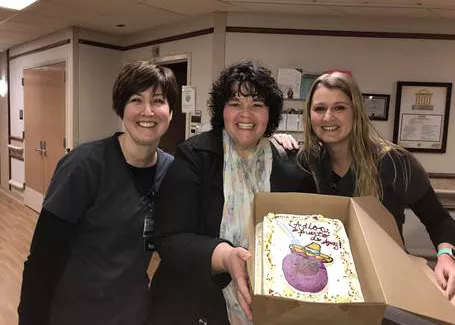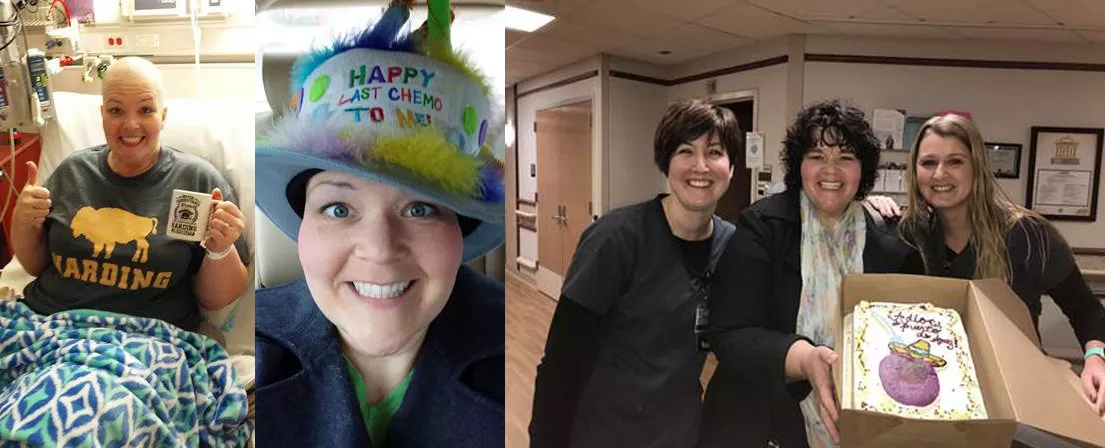Amy's sarcoma story

Just a few years ago, I was a single woman in my mid 30s living alone in a big old house in Gilman, Iowa, working long, hard hours as a family therapist, teaching a few psychology courses on the side, and baking LOTS of cupcakes for what had turned from a hobby into my little side business. I spent any spare time serving in ministries with my church or traveling as often as my bank account would allow.
My life was full, and I was juggling a lot of things, but deep within me, there was a longing for something more—a family of my own. I wondered if that dream would ever come true.
And then it did—quite suddenly! In 2014, I met a handsome widower and his two beautiful daughters. Exactly 51 weeks after our first date, I married that man, and after enough time had passed for the court to allow it, I adopted those two little ladies. My dream had come true!
A pesky little pain
Meanwhile, one day at the gym, I felt a tiny little twinge in my right knee. When it didn’t go away, I went to physical therapy, where it was diagnosed as a hamstring overcompensating for a weakness in the quad muscle.
As I was busy settling into married life, that pesky little pain in my right knee kept increasing. The physical therapist suspected something more was going on and encouraged me to get some imaging done.
Did I follow her recommendation? Not for six more months, when it finally hurt so bad that I couldn’t even get started on the elliptical. That was the breaking point—if it was preventing me from a good workout, then I should get it checked out.
So a couple of weeks after my husband and I celebrated our one-year anniversary, I went to the doctor. The X-ray didn’t show anything, so they scheduled me for an MRI. During that MRI, tears fell as I struggled to keep my leg completely still in an outstretched position.
I was driving home from the MRI when they called and asked me to come back to talk about my results. Dr. Laura Lasack was as gentle as possible as she explained there was a mass in my femur and they would be referring me to the University of Iowa for a plan of action.
The best advice of my life
A few days later, we met with Jose Morcuende, MD, who surmised that he may be able to remove the mass and use cement to repair the femur. We scheduled surgery for a few weeks later, and he ordered a routine fine-needle biopsy, which, miraculously, the hospital was able to perform that day.
We left the hospital feeling pretty good, and we decided to keep our plans for a family vacation the next week in order to have as much summer fun as possible before I’d be recovering from surgery and on crutches.
On my daughter’s 9th birthday, when I was hobbling along with a cane as we explored downtown Chicago, my phone rang. Dr. Morcuende said the biopsy indicated an aggressive tumor. I would need chemotherapy, then surgery, then more chemotherapy.
I was stunned. I still didn’t understand that it was cancer. I couldn’t tell my husband because there was no way to prevent our girls from hearing. So I waited until after our little ladies were asleep in our hotel room that night to tell him in hushed whispers. He was stunned too.
The next day, the nurse, Jodi, called and told me I needed to be in Iowa City in two days. I asked her if we could put it off so we could finish our vacation. She paused and then strongly recommended that I make it back for this appointment. I started to realize how significant this was.
I asked her if it was cancer. She told me she would have the doctor call me back. When Dr. Morcuende called for the second time, he explained that I had chondroblastic osteosarcoma. He gave me some of the best advice of my life: “Do not Google this. If you do, you will find a lot of scary things, and we need you to be ready when you get here.”
To this day, I have still not Googled it! I decided to trust my doctors and my God—both of which are far better than Google.
Meeting ‘Number 41’
I met those doctors—Mohammed “Mo” Milhem, MBBS, and Varun Monga, MBBS—two days later, just after my husband and I finished weeping and praying in the parking garage of the hospital. Dr. Mo told me he was one of 40 specialists in the United States. “This,” he said, pointing to Dr. Monga, “is Number 41.”
They had to deliver a lot of bad news that day. Their genuine compassion and empathy offered comfort in an utterly devastating situation. Dr. Monga gave me his email address and promised he would be there to help as my family and I entered uncharted waters. This was a promise he kept faithfully over my entire course of treatment.
So I was admitted for my first chemotherapy on July 21, and I handled it very well…for the first eight hours. It went downhill after that!
I’ll never forget nurse Andrea Eichler flying across my room like a ninja to give me a container that first time I got sick. It came on suddenly! I felt like a truck had run me over. I became very nauseous and fatigued.
They had to deliver a lot of bad news that day. Their genuine compassion and empathy offered comfort in an utterly devastating situation.
Making the most of cancer treatment

- At left: “One of my many hospital stays.”
- Center: “Day 1 of my last round of chemo”
- At right: “Celebrating getting my port out with two of my favorite nurses, Andrea Eichler and Jenessa Franco.”
I continued to work as long as I could. Friends from church began organizing a fundraiser, and friends from work sold T-shirts and gathered donations to help with expenses. We would not have survived financially had it not been for the goodness and generosity of such people.
I anticipated the nausea, fatigue, and weakness. But the mouth sores—those were a complete, torturous surprise. I tried pain medications, saline rinses, lidocaine rinses, ice, lozenges, etc. Even the morphine drip didn’t relieve the pain, and I was unable to eat or drink for days on end.
The one who faints
After about three months of treatment, I had surgery to replace part of my femur and my entire right knee. Benjamin Miller, MD, performed the surgery with excellence and precision, and he skillfully removed the entire tumor.
As I recovered from surgery, I gained a reputation as “the one who faints,” because every time a physical therapist would come and make me get up to try to walk, I’d pass out. The staff on the orthopedic wing were quite spry, catching me and getting me back to my bed until I gained consciousness. It took several days before I could take a step or two, and more than a week before I was able to go home.
It was very slow progress to rehabilitate my leg, and it was complicated by the fact that I resumed chemotherapy just weeks after surgery. I became weak again—so weak that I couldn’t hold a pen to write a sentence. I resumed the long hospital stays, nausea, fatigue, and the like.
Those hospital stays were lonely, although many of the nursing staff became dear friends as they took care of me so well. When my little ladies would come to visit, they’d crawl up into bed with me and I did my best to assure them that everything would be okay, even though I couldn’t promise I’d make it through my illness.
Dr. Monga stopped in my room every single day that I was in the hospital, sometimes late at night after he had worked in the clinic all day long. His commitment astounded me!
Learning to walk again
I had to learn to walk again, and that was frustrating, painful, and humbling. At home, we put a twin-size bed into a tiny room near our kitchen since I couldn’t climb the stairs to our bedroom. My husband never once complained when I would call and wake him in the middle of the night. I hated being dependent, but he was happy to support me.
Treatment ended in February of 2017. But it took a long time for some of the effects to wear off. I still deal with many of them—the neuropathy, the hearing loss, the ringing in my ears, the memory loss, the mental fogginess, and the emotional swells.
I transitioned from a wheelchair to a walker, to crutches, to a cane, and finally to walking without assistance. I’m still working on conquering stairs, although I can manage them as long as there are sturdy handrails! I returned to work about three months after treatment ended, with a lighter workload and lots of patience from my co-workers. I settled in gradually and built up my stamina each day.
I choose to live
Today, I’m still adapting to my new normal. I had to give up my side jobs because I simply couldn’t manage everything like I used to. I need to rest more, and I don’t last as long in the gym—yet!
I go back to Iowa City every 90 days for scans to check if the cancer has returned. I realize the odds are not in my favor. So I choose every day whether I will be paralyzed by fear or motivated to “suck the marrow out of life.” We have planned trips and booked tickets, we’ve allowed our little ladies to stay up way too late rather than interrupt a moment of family bonding, we’ve decided to forgive and move on. I never hold back “I love you’s,” and I cherish every moment of singing my little ladies to sleep.
My blessings are abundant and my heart is full of gratitude for this beautiful life. I choose to live.